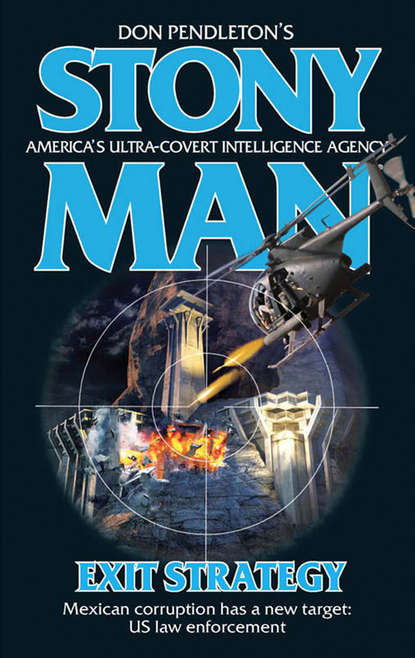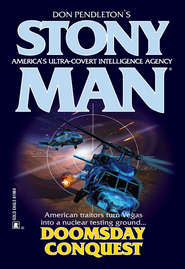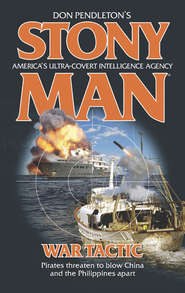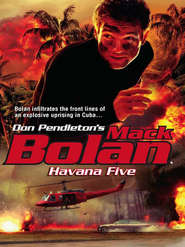По всем вопросам обращайтесь на: info@litportal.ru
(©) 2003-2024.
✖
Exit Strategy
Автор
Год написания книги
2019
Настройки чтения
Размер шрифта
Высота строк
Поля
“The loss of Stewart Crowmass,” Blancanales added.
“Well, apparently he’d lost enough iterations of the Aryan Right Coalition to have an idea who or what we are,” Brognola said. “That’s another thing that Carmen and Aaron are working on. We’re trying to erase the trails and the crumbs that would expose the President and the Justice Department.”
“So even if we bring down Accion Obrar, there’s still a chance that you’ll be made to fall on your sword? After all we’ve done for the country?” McCarter asked.
“Face it. We’ve done a lot more than just water-boarding and drone strikes,” Lyons said. “The Democrats will go nuts over civil rights violations of our targets, especially someone not proven guilty like Crowmass. The Republicans will just stamp us as another out-of-control government program and a symbol of big government picking on the innocent.”
“Crowmass was good at whipping up each party, hitting their particular hot buttons,” Schwarz added. “Even dead, he’s giving us shit.”
“Not just Stony Man,” Encizo added. “The whole country. Because if things degrade to the point where we might go to war with Mexico, the groundwork he laid might just spark a civil war.”
The Stony Man operatives got up from the meeting table. As of now, they were on the clock and more than just one life was at stake. Just as it always was. They wouldn’t have it any other way.
CHAPTER THREE (#ulink_854390a4-2c5d-5326-a6f9-0b37d6cf13b1)
When David McCarter mentioned being able to circumvent the law in getting them into Mexico without outside assistance, he’d exaggerated some. During the flight to Yuma, Arizona, where the surviving blacksuit had retreated with the Castillo children, McCarter had Rafael Encizo and Calvin James calling in favors with their friends. In addition to the blacksuits trained by Phoenix Force, James had friends in both California and Nevada police agencies from his time as a member of San Francisco SWAT, and Encizo had similar brothers in arms in the Drug Enforcement Administration.
Deputy Marshal Domingo Perez had driven south from the safe house, moving closer to the Mexican border instead of farther away. But that was a good thing; it provided a major city and airport hub. The Yuma PD, the county sheriff’s office and local FBI and USMS were present and on alert, keeping watch over the still-free family. Yuma sat only fourteen miles and change from the Mexican border, and with the Gila River and all manner of county roads webbed across the countryside, there was plenty of above-ground activity to keep an eye on.
What McCarter sought was the underground smugglers’ routes, all the way from Andrade, California, on Interstate 8 to Douglas, Arizona, on 191. Over the years, nearly one hundred covertly built tunnels had been discovered; routes by which the cartels could get between the Sonora State in Mexico to Arizona. Heroin, cocaine, guns and money flowed freely through those tunnels, and there were likely many more that hadn’t been unearthed by American and Mexican law enforcement. Both Phoenix Force and Able Team had experience with the subterranean trespasses over several missions, and McCarter was certain of one thing: if they found one end of such a tunnel, they’d be set for supplies.
Considering the state of tunnel politics, they would be going full clandestine. Sure, each member of the Force was equipped with sanitized versions of their preferred sidearms, but having access to cartel weaponry and money would be a boost of support that McCarter could truly appreciate. After all, one way that Stony Man was able to keep its chunk of the US government’s black budget so small was thanks to rules of engagement that stated the blood money assembled by drug dealers and terrorists would be well spent turned back against them. Over the years Stony Man kept a minimal footprint despite its government sanctions, having adopted Mack Bolan’s rule of robbing the robbers.
Hitting the end of a smuggler pipeline would not be anything new for the team.
Encizo’s nodding increased in frequency, his expressions growing more excited as he spoke in rapid Spanish to the person on the other end of his call. McCarter smiled, snapping his fingers to get the attention of the others, none of which showing signs of a solid lead.
While Encizo had his cell phone to his left ear, his right hand was busy scribbling down notes. He was on to a very hot lead, which was exactly what McCarter wanted. Everything was written down in pencil, because McCarter watched the eraser bob and wag with each new bit of info.
After a seeming eternity, Encizo was finally off the phone.
“Whatcha got?”
Encizo grinned at McCarter. “Nogales, Arizona. Here’re the notes.”
McCarter took the pad, reading up and down.
In essence, the Nogales site was one that was heavily suspected, thanks to weeks of surveillance, but both Mexican and American judges were dragging their feet. It was, little doubt, due to pressure from one of many cartels. In years past, the cartels had carried out assassinations and other attempted murders on both sides of the line, irrespective of the tourist draw of the small cities and, according to the local DEA, Los Lictors had picked up the slack.
That the enforcer gang seemed to be doing a lot of cleanup of rival cartels, while drugs still flowed across the border, was a sign that Mexican federales and military were working in collusion with “the Magistrates.” In particular, the report claimed the government was helping the Caballeros de Durango Cartel to take control of the Juarez Valley area and destroy other cartels.
Joaquin and Amanda Castillo had personally interviewed dozens of officials and ordinary people for their investigation. One report quoted a former Juarez police commander who claimed the entire department was working for the Knights of Durango Cartel and helping it to fight other groups. He’d also asserted that the cartel had bribed the military. Also quoted was a Mexican reporter who’d stated hearing numerous times from the public that the military had been involved in murders.
Further evidence appeared in the US trial of an ex-Juarez police captain who admitted to working for the cartel. He asserted that the Durango Cartel influenced the Mexican government and military in order to gain control of the region. A US DEA agent in the same trial alleged that the bent cop had contacts with a Mexican military officer. The report also stated, with support from an anthropologist who studied drug trafficking, that data on the low arrest rate of Durango Cartel members was evidence of favoritism on the part of the authorities. A Mexican official denied the allegation of favoritism, and a DEA agent and a political scientist also had alternate explanations for the arrest data. Another report detailed numerous indications of cartel corruption and influence within the Mexican government.
The ties between Los Lictors and the Knights of Durango Cartel were strong and apparent, but the Castillos, in uncovering those ties to the Mexican federales and the armed forces, had drawn down enormous heat. Their evidence threatened a lot of powerful people south of the border.
That the tunnel was owned by the Knights of Durango was icing on Phoenix Force’s cake.
“That’s a lot of good intel,” Hawkins said. “Damned shame that Mexican judges and American Feds are afraid to take the dive into shutting down such a sewer.”
“No shame at all, brother T.J.” James spoke up. “With this pipeline still open, it gives us a walk through an unlocked back door.”
McCarter nodded. “Hey, up front, can you drop us off at Nogales?” he asked their pilots.
“Not a problem” came the response. Jack Grimaldi and Charlie Mott served as the flight crew of the Stony Man Gulfstream jet. Outfitted with top-of-the-line avionics, storage facilities that could hide an armory, and double the normal range of a standard private jet, the aircraft would have little problem stopping at one airport or another. With Grimaldi and Mott at the controls, the plane could be set down on the shortest of municipal runways if necessary. Stealth electronics would also help it land inside an enemy nation without notice if need be.
Carl Lyons agreed with the air crew’s assessment. “Currently, Deputy Perez and the kids are surrounded by a ring of armed lawmen.”
“A bigger one than the last protection team, at least,” Schwarz amended.
“As brazen as the assault on the Arizona safe house, it still was less blatant than an incident at a federal building in Yuma,” Blancanales added. “We can spare a half hour to drop you off.”
“Thanks,” McCarter returned. “It’ll save us the stress of driving and prepping for an assault across country.”
“You’re not the only one planning in the cabin, David,” Lyons said.
McCarter smirked. “How’s your work going?” he asked Schwarz.
“Well, since we have the enemy wanting to come to us, we’ll just figure out the best place to draw them in. Lines of fire, dirty tricks to even the odds, all manner of shenanigans,” Schwarz added. “Like at Gary’s place. Remember when the Russians took a run at you in Montana?”
Manning’s lips curled into a slight smile. When elements of the Russian espionage machine had grown tired of Phoenix Force’s interference in their operations, they’d launched an all-out effort to exterminate the group. Two hundred men, from the Spetsnaz and various wet-works agencies, were thrown at Phoenix. The first few skirmishes were not much, but Manning and the others had let the Russians know where to find them in the remote cabin in the Rockies.
There, Phoenix Force had sniper rifles, booby traps and explosive mines set up to turn the assault force into carrion for scavengers. The team survived, and those who’d believed in the old Soviet corruption ways had been taught a very expensive lesson.
“Knowing what battlefield you’ll be facing your enemy on goes a long way toward evening the odds,” Manning observed.
“Evening the odds?” Blancanales asked. “We want every unfair advantage in the book.”
“Truth spoken,” McCarter agreed. “Whoever said cheaters never win hasn’t studied his military history.”
“Any particular gear you bringing on this mission?” Lyons asked.
“I’m missing my old MAC-10, and Rafe loves his Heckler & Kochs, so we decided to split the difference and pack the MP-7. We’ve got suppressors and proper ammo for quiet hits as well as loud,” McCarter explained.
“Yeah, got to love the old tried-and-true T-grip style,” Schwarz added.
Lyons wrinkled his nose. “I’m barely comfortable with the .22s that come out of an M16. But 4.6 mm? That’s only .18 caliber.”
“Well, that’s the thing, Carl. Rafe and I actually know how to shoot,” McCarter answered with a wink. “Plus, everyone we’ve hit with those little .18-caliber bullets has been suitably impressed and hasn’t complained.”
Lyons chuckled.
“Since Cal and I are AR guys, we’re rolling out with these stubbies based on the DPMS PDWs,” T. J. Hawkins added. “Seven-inch heavy barrel AR-15s and a nice little name.”
James smirked. “Technically, it’s not called the Kitty Kat anymore in that configuration.”
“If our founder could have his Big Thunder, then I’m entitled to my Kitty,” Hawkins returned.











